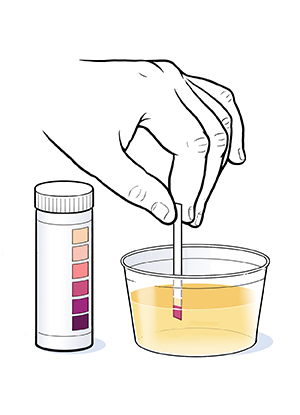Discharge Instructions: Checking for Ketones
Glucose is a kind of sugar from food. It's your body's normal energy source. Your body uses a hormone called insulin to help glucose get into your cells. People with diabetes don't make insulin. Or their body can't use insulin well.
If your body doesn't have enough insulin to use glucose, your body starts burning fat instead. When fat is burned, it makes chemicals called ketones. Ketones can build up in the blood and urine. This buildup can cause a dangerous condition called ketoacidosis. Diabetic ketoacidosis (DKA) can lead to diabetic coma or death. For this reason, you need to check for ketones at times when you are most at risk.
When to check for ketones
Check for ketones, especially if you have type 1 diabetes. Do this when any of the following is true, or as directed by your healthcare provider:
-
Your blood sugar is above 240 mg/dL.
-
You are ill or under stress.
-
You have diarrhea or stomach pain.
-
You are very thirsty.
-
You need to urinate often.
-
You have a dry mouth.
-
Your breath smells "fruity."
-
You feel sick or nauseated. Or you have vomited and are becoming dehydrated.
-
You have run out of your usual diabetes medicines and can't get them right away. This is especially true if you use insulin.
It's also important to check for ketones if you have type 2 diabetes and are taking a certain type of medicine (SGLT-2 inhibitors).
How to check for ketones
Tips for checking for ketones:
-
Use testing tablets or strips. Different test kits are available from your pharmacy.
-
Depending on the kit, you can check for ketones in your urine or in your blood. Follow the directions on the packaging.
-
Record your test results. Show them to your healthcare provider at your next visit.
-
Call your healthcare provider right away if you test positive for ketones. Follow the directions in your sick day guidelines on what to do when you have high glucose and ketones.
-
Do not exercise if you find ketones in your blood or urine and your blood sugar is high.
Urine tests
 |
| Urine tests are one way of checking ketones. |
Tips for using urine tests:
-
Follow the package directions carefully.
-
Use a clean container to get a sample of your urine. You can clean a container by washing it with soap and water.
-
Place the test strip in the urine sample. Or pass the strip through your urine stream.
-
Gently shake extra urine off the strip.
-
Wait for the strip to change color. The directions will tell you how long to wait.
-
Compare the strip with the color chart on the bottle or package. This gives you a range for the number of ketones in your urine.
-
Record your results.
Blood tests
Tips for testing your blood:
To learn more
The resources below can help you learn more:
Follow-up
Make a follow-up appointment, or as advised.
When to call your healthcare provider
Call your healthcare provider right away or go to the nearest emergency room if any of the following occur:
-
Moderate to large amounts of ketones, or as advised by your healthcare provider
-
Fever of 100.4°F (38°C) or higher, or as advised by your healthcare provider
-
Tiredness (fatigue)
-
Dry or flushed skin
-
Nausea or vomiting
-
Stomach pain
-
Trouble breathing
-
A sweet, fruity odor on your breath
-
Confusion
Online Medical Reviewer:
Rajadurai Samnishanth Researcher
Online Medical Reviewer:
Raymond Kent Turley BSN MSN RN
Online Medical Reviewer:
Sara Mauldin FNP
Date Last Reviewed:
12/1/2024
© 2000-2025 The StayWell Company, LLC. All rights reserved. This information is not intended as a substitute for professional medical care. Always follow your healthcare professional's instructions.